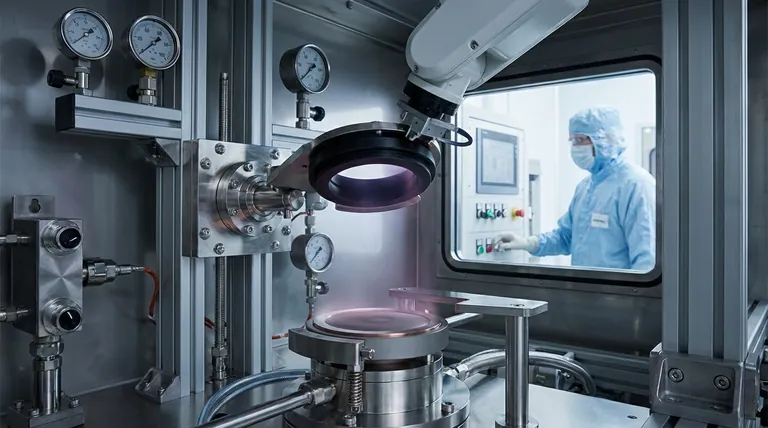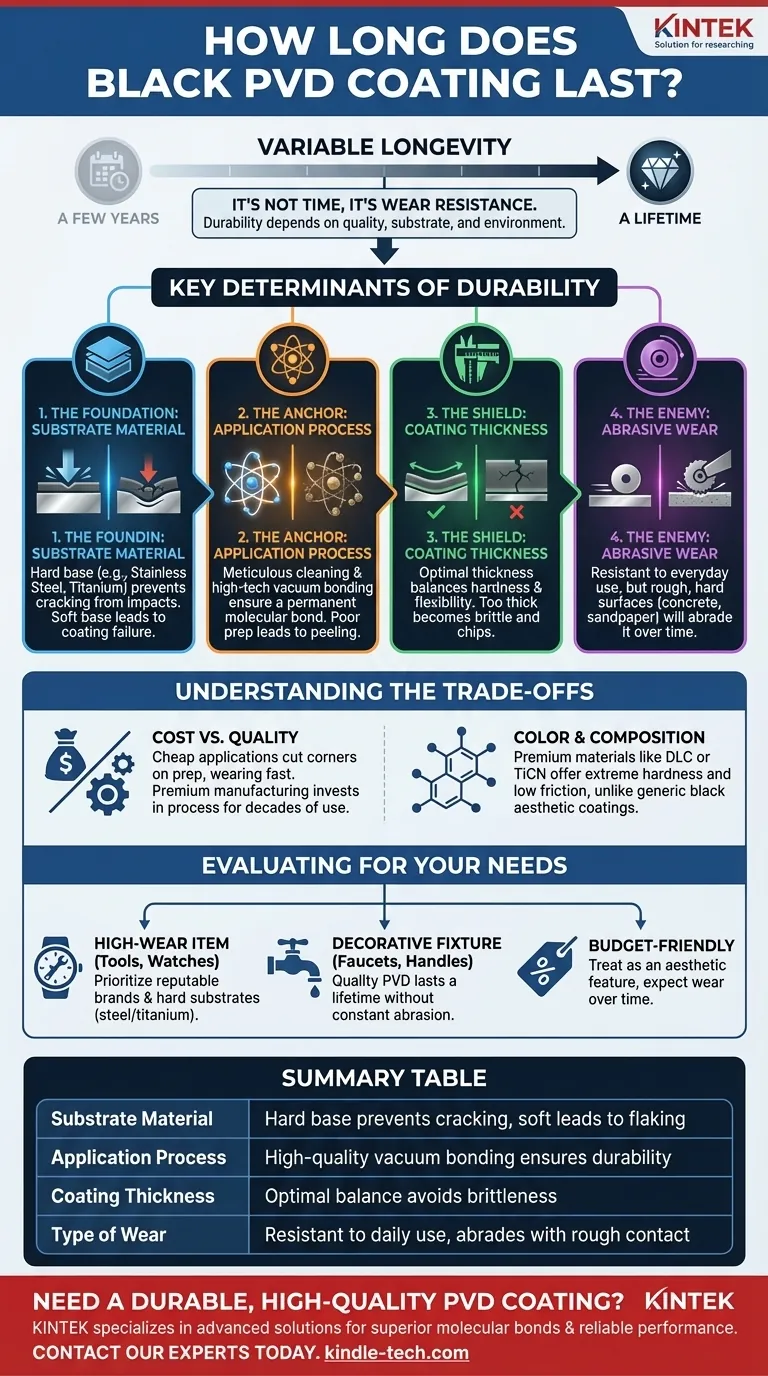The longevity of a black PVD coating is not a fixed timeframe but a variable that can range from a few years to a lifetime. A high-quality Physical Vapor Deposition (PVD) coating on a durable base material can easily last for decades without fading or chipping under normal use. However, the actual lifespan depends heavily on the quality of the application process, the hardness of the underlying material, and the type of wear it endures.
The core issue is not how many years a PVD coating lasts, but how it resists wear. Its durability is a direct result of the manufacturing process and the environment it's exposed to, making the quality of the application far more important than a simple time-based estimate.

What Determines PVD Coating Durability?
Physical Vapor Deposition is a process, not a single material. The significant variation in its lifespan comes from several key factors that work together to create the final, durable finish.
The Foundation: Substrate Material
The material underneath the coating is just as important as the coating itself. PVD is a very thin, hard layer deposited onto a substrate, such as stainless steel or titanium.
If the base material is soft, a significant impact can dent the substrate. This deformation can cause the hard PVD layer above it to crack or flake, as the foundation it was bonded to has failed. A hard substrate like 316L stainless steel provides a rigid base, making the entire component more resistant to scratches and damage.
The Anchor: Application Process and Bond Strength
This is the most critical factor. The PVD process involves depositing a material, atom by atom, onto the substrate in a high-tech vacuum chamber. The strength of the molecular bond created during this process determines whether the coating will last.
A high-quality application involves meticulous, multi-stage cleaning of the substrate to remove any microscopic contaminants. Any failure in this step will result in a weak bond, leading to peeling or flaking down the line. The manufacturer's process control and quality standards are paramount.
The Shield: Coating Thickness
While it may seem intuitive that thicker is better, this isn't always the case. There is an optimal thickness for PVD coatings that balances hardness with flexibility.
An excessively thick coating can become brittle and more prone to chipping on impact. A properly engineered coating is thick enough to provide a substantial wear-resistant layer but thin enough to avoid brittleness.
The Enemy: Abrasive Wear
The final variable is how you use the product. A PVD-coated watch bracelet that is constantly scraped against a desk will wear faster than a decorative faucet.
While high-quality PVD is extremely scratch-resistant against everyday objects, it is not scratch-proof. Hard, rough surfaces like concrete, sandpaper, or diamond can abrade the coating over time.
Understanding the Trade-offs
Not all black PVD finishes are created equal. The term is used broadly in marketing, but the underlying quality can vary dramatically, which is often reflected in the price.
Cost vs. Quality Control
Achieving a strong, permanent bond requires expensive machinery and rigorous process controls. Cheaper PVD applications often cut corners on the crucial substrate preparation and deposition steps.
This is why a PVD coating on a budget item might scratch or wear off within a year or two, while a coating from a premium manufacturer on a watch or high-end tool will appear new after a decade.
Color and Composition
The specific materials used to create the black color also affect its properties. Coatings like Titanium Carbonitride (TiCN) or Diamond-Like Carbon (DLC) are often used for black finishes and are known for their extreme hardness and low friction.
A generic "black coating" may not use these premium materials, resulting in a finish that is more for aesthetics than for true durability.
Evaluating PVD for Your Needs
Instead of asking "how long" it will last, it's better to evaluate the coating based on your intended use and the reputation of the manufacturer.
- If your primary focus is a high-wear item (like a watch, tool, or knife): Prioritize brands known for quality manufacturing and look for products with a hard substrate like stainless steel or titanium.
- If your primary focus is a decorative fixture (like a faucet or door handle): Most PVD coatings from reputable brands will last a lifetime, as they are not subject to constant abrasive wear.
- If your primary focus is a budget-friendly item: Treat the PVD coating as an aesthetic feature that may show wear over time, and do not expect the lifetime durability of a premium product.
Ultimately, a quality PVD finish is not just a color, but a permanent fusion of materials engineered for resilience.
Summary Table:
| Factor | Impact on PVD Coating Lifespan |
|---|---|
| Substrate Material | A hard base (e.g., stainless steel) prevents cracking; a soft base leads to flaking. |
| Application Process | High-quality bonding in a vacuum chamber ensures a permanent, durable finish. |
| Coating Thickness | An optimal thickness balances hardness and flexibility to prevent chipping. |
| Type of Wear | Resistant to everyday use but can abrade from constant contact with hard, rough surfaces. |
Need a Durable, High-Quality PVD Coating for Your Products?
At KINTEK, we specialize in advanced PVD coating solutions for laboratory equipment, tools, and precision components. Our expertise ensures a superior molecular bond to your substrate, providing a finish that is engineered for decades of reliable performance, not just aesthetics.
We serve manufacturers who demand durability and precision. Let us help you enhance your product's longevity and resistance to wear.
Contact our experts today to discuss your specific coating requirements and how we can add value to your manufacturing process.
Visual Guide

Related Products
- Custom CVD Diamond Coating for Lab Applications
- RF PECVD System Radio Frequency Plasma-Enhanced Chemical Vapor Deposition RF PECVD
- Vacuum Hot Press Furnace Machine for Lamination and Heating
- Silicon Carbide (SIC) Ceramic Sheet Wear-Resistant Engineering Advanced Fine Ceramics
- Molybdenum Disilicide (MoSi2) Thermal Elements Electric Furnace Heating Element
People Also Ask
- How long does diamond coating last? Maximize Lifespan with the Right Coating for Your Application
- How are tools coated with diamond? Achieve Superior Hardness and Low Friction for Your Tools
- What is diamond coating film? A Thin Layer of Diamond for Extreme Performance
- What is the process of CVD diamond coating? Grow a Superior, Chemically-Bonded Diamond Layer
- What are diamond coated films? Enhance Materials with Super-Hard, Transparent Layers
















